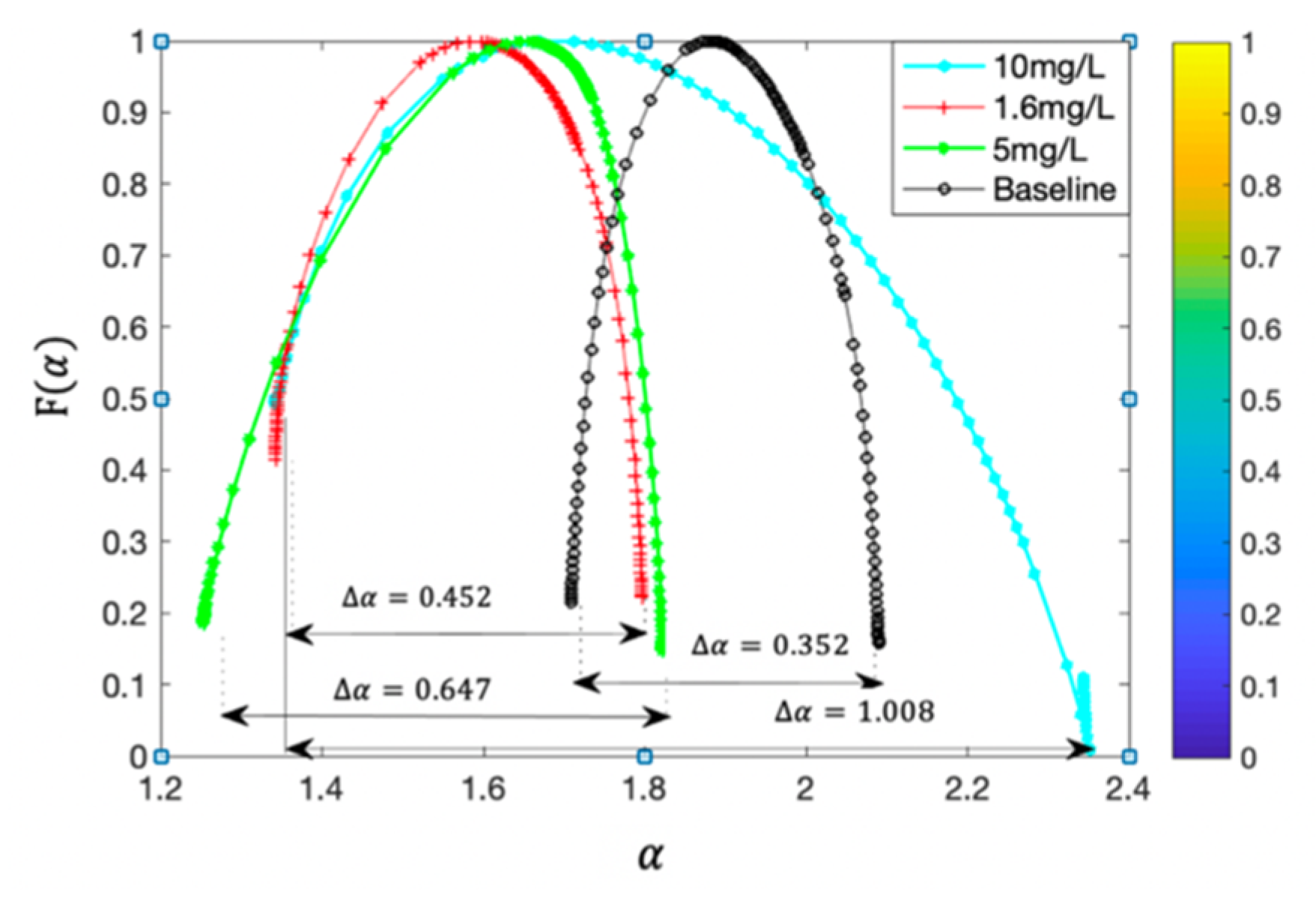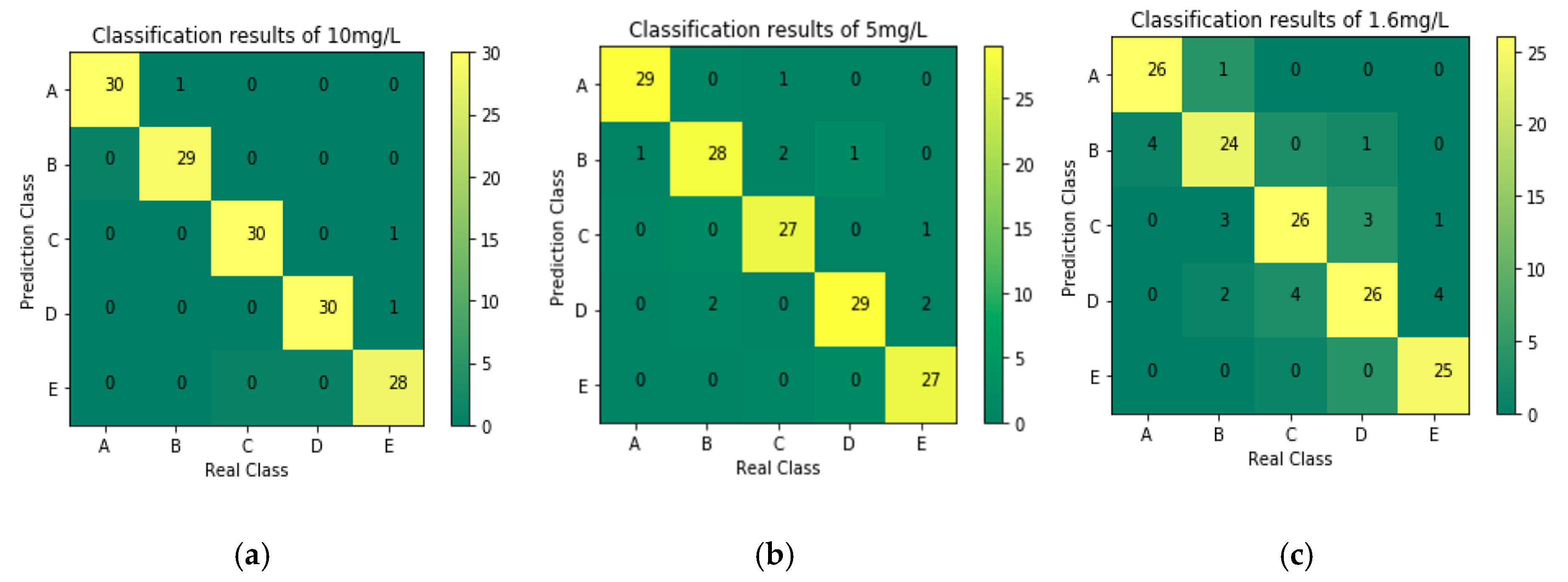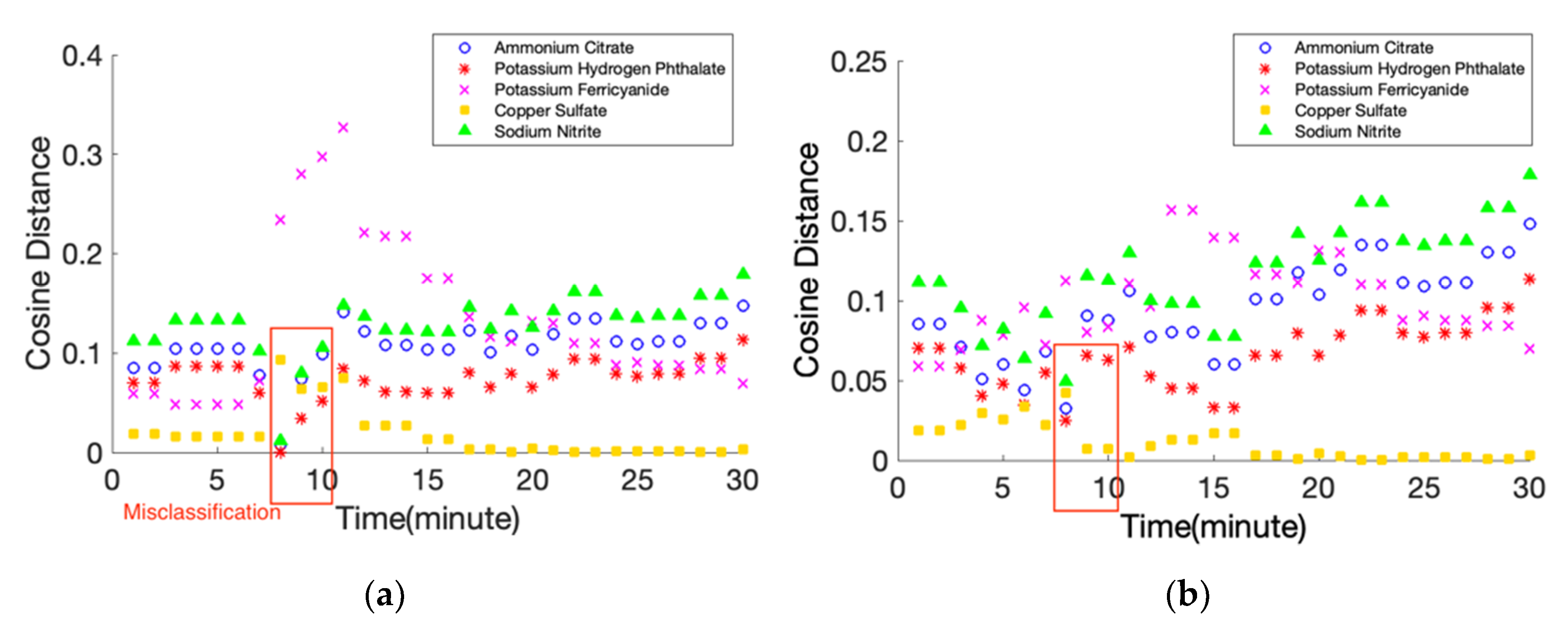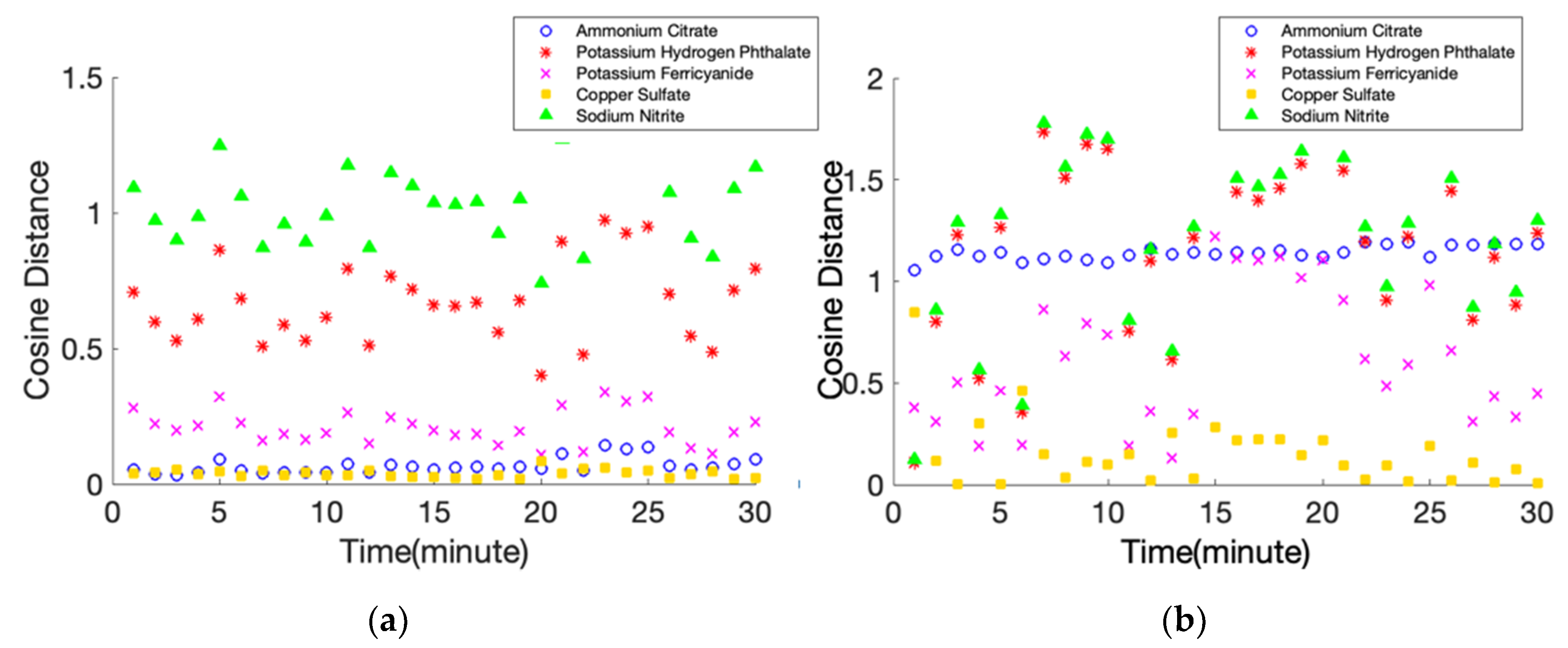An Online Contaminant Classification Method Based on MF-DCCA Using Conventional Water Quality Indicators †
Abstract
1. Introduction
2. Methods and Experiment
2.1. Principles and Methodology
2.1.1. Abnormal Fluctuation Analysis of Single Indicator Based on MF-DFA
2.1.2. Cross-correlation Analysis of Multiple Indicators Based on MF-DCCA
- Divide and into pieces of data of length s, that is, .
- Calculate the cross-correlation fluctuation function between and :and , respectively, represent the local trend of time series and .
- Calculate the de-trending covariance function of order q between time series and :
- (1)
- When there is a long-range correlation between time series and , the relationship between and is as follows:is a generalized cross-correlation Hurst exponent.
- (2)
- The de-trend cross-correlation index of time series and is:According to the Legendre transformation, we can get this relationship:
2.1.3. Abnormal Probability Fusion Based on D–S Evidential Theory
2.1.4. Constructing Eigenvector and Classifying Based on Cosine Distance
2.2. Part of the Experiment
2.2.1. Experimental Apparatus
2.2.2. Experimental Scheme Design
3. Results and Discussion
3.1. The Result of Single Indicator Fluctuation Analysis
3.2. Cross-Correlation Analysis of Multiple Indicators and Comparison of Probability Fusion Results
3.3. Comparison of Contaminant Classification Results
4. Conclusions
Author Contributions
Funding
Acknowledgments
Conflicts of Interest
References
- Gullick, R.W.; Gaffney, L.J.; Crockett, C.S.; Schulte, J.; Gavin, A.J. Developing regional early warning systems for US source waters. J. Am. Water Work. Assoc. 2004, 96, 68–82. [Google Scholar] [CrossRef]
- Storey, M.V.; Van der Gaag, B.; Burns, B.P. Advances in on-line drinking water quality monitoring and early warning systems. Water Res. 2011, 45, 741–747. [Google Scholar] [CrossRef]
- De Hoogh, C.J.; Wagenvoort, A.J.; Jonker, F.; van Leerdam, J.A.; Hogenboom, A.C. HPLC-DAD and Q-TOF MS techniques identify cause of Daphnia biomonitor alarms in the River Meuse. Environ. Sci. Technol. 2006, 40, 2678–2685. [Google Scholar] [CrossRef]
- Jeon, J.; Kim, J.H.; Lee, B.C.; Kim, S.D. Development of a new biomonitoring method to detect the abnormal activity of Daphnia magna using automated Grid Counter device. Sci. Total Environ. 2008, 389, 545–556. [Google Scholar] [CrossRef] [PubMed]
- Henderson, R.K.; Baker, A.; Murphy, K.; Hambly, A.; Stuetz, R.; Khan, S. Fluorescence as a potential monitoring tool for recycled water systems: A review. Water Res. 2009, 43, 863–881. [Google Scholar] [CrossRef]
- Kroll, D.J. Securing Our Water Supply: Protecting a Vulnerable Resource; PennWell Corporation: Tulsa, OK, USA, 2006. [Google Scholar]
- Yang, Y.J.; Haught, R.C.; Goodrich, J.A. Real-time contaminant detection and classification in a drinking water pipe using conventional water quality sensors: Techniques and experimental results. J. Environ. Manag. 2009, 90, 2494–2506. [Google Scholar] [CrossRef] [PubMed]
- Liu, S.M.; Che, H.; Smith, K.; Chang, T. A real time method of contaminant classification using conventional water quality sensors. J. Environ. Manag. 2015, 154, 13–21. [Google Scholar] [CrossRef] [PubMed]
- Liu, S.M.; Che, H.; Smith, K.; Chang, T. Contaminant classification using cosine distances based on multiple conventional sensors. Environ. Sci.-Proc. Imp. 2015, 17, 343–350. [Google Scholar] [CrossRef] [PubMed]
- Huang, P.J.; Jin, Y.; Hou, D.B.; Yu, J.; Tu, D.Z.; Cao, Y.T.; Zhang, G.X. Online Classification of Contaminants Based on Multi-Classification Support Vector Machine Using Conventional Water Quality Sensors. Sensors 2017, 17, 581. [Google Scholar] [CrossRef]
- Kantelhardt, J.W.; Zschiegner, S.A.; Koscielny-Bunde, E.; Havlin, S.; Bunde, A.; Stanley, H.E. Multifractal detrended fluctuation analysis of nonstationary time series. Physica A 2002, 316, 87–114. [Google Scholar] [CrossRef]
- Zhou, W.X. Multifractal detrended cross-correlation analysis for two nonstationary signals. Phys. Rev. E 2008, 77. [Google Scholar] [CrossRef] [PubMed]
- Dutta, S.; Ghosh, D.; Chatterjee, S. Multifractal detrended cross correlation analysis of foreign exchange and SENSEX fluctuation in Indian perspective. Phys. A: Stat. Mech. Appl. 2016, 463, 188–201. [Google Scholar] [CrossRef]
- Huang, J.; Gu, D. Multiscale Multifractal Detrended Cross-Correlation Analysis of High-Frequency Financial Time Series. Fluct. Noise Lett. 2019, 18, 1950014. [Google Scholar] [CrossRef]
- Cai, Y.; Hong, J. Dynamic relationship between stock market trading volumes and investor fear gauges movements. Appl. Econ. 2019, 51, 4218–4232. [Google Scholar] [CrossRef]
- Fang, S.; Lu, X.; Li, J.; Qu, L. Multifractal detrended cross-correlation analysis of carbon emission allowance and stock returns. Phys. A Stat. Mech. Appl. 2018, 509, 551–566. [Google Scholar] [CrossRef]
- Manimaran, P.; Narayana, A. Multifractal detrended cross-correlation analysis on air pollutants of University of Hyderabad Campus, India. Phys. A Stat. Mech. Appl. 2018, 502, 228–235. [Google Scholar] [CrossRef]
- Laib, M.; Telesca, L.; Kanevski, M. Long-range fluctuations and multifractality in connectivity density time series of a wind speed monitoring network. Chaos Interdiscip. J. Nonlinear Sci. 2018, 28, 033108. [Google Scholar] [CrossRef]
- Stan, C.; Cristescu, M.T.; Luiza, B.I.; Cristescu, C. Investigation on series of length of coding and non-coding DNA sequences of bacteria using multifractal detrended cross-correlation analysis. J. Theor. Biol. 2013, 321, 54–62. [Google Scholar] [CrossRef]
- Pal, M.; Satish, B.; Srinivas, K.; Rao, P.M.; Manimaran, P. Multifractal detrended cross-correlation analysis of coding and non-coding DNA sequences through chaos-game representation. Phys. A Stat. Mech. Appl. 2015, 436, 596–603. [Google Scholar] [CrossRef]
- Dutta, S.; Ghosh, D.; Samanta, S. Non linear approach to study the dynamics of neurodegenerative diseases by Multifractal Detrended Cross-correlation Analysis—A quantitative assessment on gait disease. Phys. A Stat. Mech. Appl. 2016, 448, 181–195. [Google Scholar] [CrossRef]
- Yin, Y.; Shang, P. Multiscale multifractal detrended cross-correlation analysis of traffic flow. Nonlinear Dyn. 2015, 81, 1329–1347. [Google Scholar] [CrossRef]
- Wang, F.; Liao, G.-P.; Zhou, X.-Y.; Shi, W. Multifractal detrended cross-correlation analysis for power markets. Nonlinear Dyn. 2013, 72, 353–363. [Google Scholar] [CrossRef]
- Dempster, A.P. Upper and Lower Probabilities Induced by a Multivalued Mapping. Ann. Math Stat. 1967, 38. [Google Scholar] [CrossRef]
- Shafer, G. A Mathematical Theory of Evidence; Princeton University Press: Princeton, New Jersey, USA, 1976; Volume 42. [Google Scholar]
- Li, W.; Bao, J.; Fu, X.; Fortino, G.; Galzarano, S. Human postures recognition based on DS evidence theory and multi-sensor data fusion. In Proceedings of the 2012 12th IEEE/ACM International Symposium on Cluster, Cloud and Grid Computing (ccgrid 2012), Ottawa, ON, Canada, 13–16 May 2012; pp. 912–917. [Google Scholar]
- Kushwah, A.; Kumar, S.; Hegde, R.M. Multi-sensor data fusion methods for indoor activity recognition using temporal evidence theory. Pervasive Mob. Comput. 2015, 21, 19–29. [Google Scholar] [CrossRef]
- Mogaji, K.A.; Lim, H.S. Application of Dempster-Shafer theory of evidence model to geoelectric and hydraulic parameters for groundwater potential zonation. NRIAG J. Astron. Geophys. 2018, 7, 134–148. [Google Scholar] [CrossRef]
- Al-Abadi, A.M. The application of Dempster–Shafer theory of evidence for assessing groundwater vulnerability at Galal Badra basin, Wasit governorate, east of Iraq. Appl. Water Sci. 2017, 7, 1725–1740. [Google Scholar] [CrossRef]
- González, C.; Castillo, M.; García-Chevesich, P.; Barrios, J. Dempster-Shafer theory of evidence: A new approach to spatially model wildfire risk potential in central Chile. Sci. Total Environ. 2018, 613, 1024–1030. [Google Scholar] [CrossRef]
- Shi, J.-Y.; Gao, K.; Shang, X.-Q.; Yiu, S.-M. LCM-DS: A novel approach of predicting drug-drug interactions for new drugs via Dempster-Shafer theory of evidence. In Proceedings of the IEEE International Conference on Bioinformatics and Biomedicine, Shenzhen, China, 15–18 December 2016; pp. 512–515. [Google Scholar]
- Pascasio, A.A. An inequality on the cosines of a tight distance-regular graph. Linear Algebra Appl. 2001, 325, 147–159. [Google Scholar] [CrossRef][Green Version]
- Senoussaoui, M.; Kenny, P.; Stafylakis, T.; Dumouchel, P. A Study of the Cosine Distance-Based Mean Shift for Telephone Speech Diarization. IEEE/ACM Trans. Audio Speech Lang. Process. 2014, 22, 217–227. [Google Scholar] [CrossRef]










| Chemicals | Concentration of Chemicals | Concentration of Contaminants | Number of Sampling Point |
|---|---|---|---|
| Ammonium Citrate | 400 mg/L | 8 mg/L | 30 |
| Potassium Hydrogen Phthalate | 300 mg/L | 6 mg/L | 30 |
| Sodium Nitrite | 200 mg/L | 4 mg/L | 30 |
| Potassium Ferricyanide | 100 mg/L | 2 mg/L | 30 |
| Copper Sulfate | 50 mg/L | 1 mg/L | 30 |
| Chemicals | Concentration of Chemicals | Concentration of Contaminants | Number of Sampling Point |
|---|---|---|---|
| 500 mg/L | 10 mg/L | 30 | |
| Five kinds of contaminants | 250 mg/L | 5.0 mg/L | 30 |
| 80 mg/L | 1.6 mg/L | 30 |
| Contaminants | (1) | (2) | (3) | (4) | (5) | (6) | |
|---|---|---|---|---|---|---|---|
| Indicators | |||||||
| pH | 0.239 | 0.457 | 0.529 | 0.244 | 0.721 | 0.218 | |
| Conductivity | 0.314 | 0.349 | 0.297 | 0.295 | 0.326 | 0.307 | |
| Turbidity | 0.198 | 0.323 | 0.176 | 0.185 | 0.443 | 0.632 | |
| Dissolved Oxygen | 0.562 | 0.690 | 0.723 | 0.476 | 0.396 | 0.891 | |
| COD | 0.881 | 1.038 | 0.989 | 1.149 | 1.324 | 0.923 | |
| Permanganate Indicator | 0.135 | 0.118 | 0.126 | 0.148 | 0.154 | 0.147 | |
| TOC | 0.947 | 1.125 | 2.846 | 1.221 | 1.336 | 0.996 | |
| Ammonia Nitrogen | 0.352 | 1.469 | 0.456 | 1.983 | 1.009 | 0.380 | |
| Nitrate Nitrogen | 0.702 | 0.626 | 1.271 | 0.746 | 0.665 | 0.896 | |
| Total Phosphorus | 0.149 | 0.155 | 0.137 | 0.142 | 0.162 | 0.128 | |
| Total Nitrogen | 0.165 | 0.169 | 0.154 | 0.138 | 0.161 | 0.157 | |
| Residual Chlorine | 0.427 | 0.477 | 0.394 | 0.975 | 1.437 | 0.451 | |
| Concentration(mg/L) | 1.6 | 5 | 10 | Average Improvement | ||||
|---|---|---|---|---|---|---|---|---|
| Contaminants | Before After | Before After | Before After | |||||
| Ammonium Citrate | 0.73 | 0.87 | 0.93 | 0.97 | 0.97 | 1 | 7.98% | |
| Potassium Hydrogen Phthalate | 0.67 | 0.80 | 0.87 | 0.93 | 0.93 | 0.97 | 9.31% | |
| Potassium Ferricyanide | 0.70 | 0.87 | 0.83 | 0.90 | 0.97 | 1 | 10.80% | |
| Copper Sulfate | 0.77 | 0.90 | 0.90 | 0.97 | 1 | 1 | 7.49% | |
| Sodium Nitrite | 0.67 | 0.83 | 0.83 | 0.90 | 0.90 | 0.93 | 10.83% | |
| Concentration(mg/L) | 1.6 | 5 | 10 | Average | |
|---|---|---|---|---|---|
| Methods | |||||
| Method 1 | 0.57 | 0.80 | 0.93 | 0.77 | |
| Method 2 | 0.73 | 0.83 | 0.93 | 0.83 | |
| Method 3 | 0.77 | 0.90 | 0.99 | 0.87 | |
| Our method | 0.90 | 0.98 | 1.00 | 0.96 | |
© 2020 by the authors. Licensee MDPI, Basel, Switzerland. This article is an open access article distributed under the terms and conditions of the Creative Commons Attribution (CC BY) license (http://creativecommons.org/licenses/by/4.0/).
Share and Cite
Zhu, Y.; Wang, K.; Lin, Y.; Yin, H.; Hou, D.; Yu, J.; Huang, P.; Zhang, G. An Online Contaminant Classification Method Based on MF-DCCA Using Conventional Water Quality Indicators. Processes 2020, 8, 178. https://doi.org/10.3390/pr8020178
Zhu Y, Wang K, Lin Y, Yin H, Hou D, Yu J, Huang P, Zhang G. An Online Contaminant Classification Method Based on MF-DCCA Using Conventional Water Quality Indicators. Processes. 2020; 8(2):178. https://doi.org/10.3390/pr8020178
Chicago/Turabian StyleZhu, Yanni, Kexin Wang, Youxin Lin, Hang Yin, Dibo Hou, Jie Yu, Pingjie Huang, and Guangxin Zhang. 2020. "An Online Contaminant Classification Method Based on MF-DCCA Using Conventional Water Quality Indicators" Processes 8, no. 2: 178. https://doi.org/10.3390/pr8020178
APA StyleZhu, Y., Wang, K., Lin, Y., Yin, H., Hou, D., Yu, J., Huang, P., & Zhang, G. (2020). An Online Contaminant Classification Method Based on MF-DCCA Using Conventional Water Quality Indicators. Processes, 8(2), 178. https://doi.org/10.3390/pr8020178







